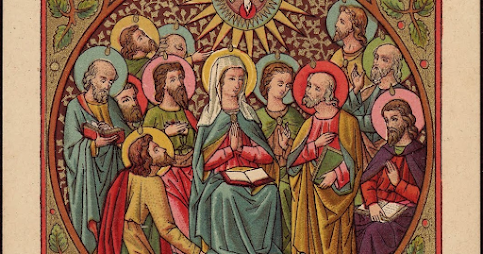Pentecost Sunday – Mary's role in the Church at Pentecost echoes the Annunciation
The parallels between the Annunciation and Pentecost might at first not be altogether apparent. However, on closer inspection, the relationship between the two becomes increasingly evident.
At the Annunciation, Mary, by the grace of God and through the action of the Holy Spirit, gave birth to Christ – God and man. As St. Luke writes: “The Holy Ghost shall come upon thee, and the power of the most High shall overshadow thee.” (Luke 1:35) Through this action of the Holy Sprit, Mary conceives a child, who is then brought forth from her womb into the world for the salvation of mankind.
Through this descending of the Holy Spirit upon her, she gives birth to Life Himself, and is thus mother of God, but also Co-Redeemer and Mediatrix of graces. With her single word of fiat, she opens the door to Life and salvation, becoming a co-operator in that work of redemption. Her actions accompanying Christ are hidden, yet are nevertheless key, and on Calvary Mary appears in the Gospel texts once more, offering herself along with her Son.
What of Pentecost? Mary, accompanying the Apostles in the upper room as pious tradition recounts, is thus present when the Holy Spirit descends upon them. “And suddenly there came a sound from heaven, as of a mighty wind coming, and it filled the whole house where they were sitting. And there appeared to them parted tongues as it were of fire, and it sat upon every one of them: And they were all filled with the Holy Ghost, and they began to speak with divers tongues, according as the Holy Ghost gave them to speak.” (Acts 2: 2)
READ: PENTECOST SUNDAY - MARY'S ROLE AS MOTHER OF THE CHURCH
Once again, through the action of the Holy Spirit, Mary – as mother, type, model and most perfect member of the Church – sends forth the means of life into the world. Yet instead of bringing forth Life Himself from her womb, this time she sends forth His successors, the Apostles, who leave the hidden confines of the upper room to address the peoples, baptising and converting. Once again, her role in this new age of the Church is hidden, yet crucial, for did not Christ give her to the Church as Mother from the cross?
Thus, just how she, as mother of God, brought forth Life into the world for the salvation of souls, so now, as mother of the Church, she sends forth life once again – spiritual life, as conveyed through the life of grace imparted to souls through the teaching and baptising of Christ’s newly ordained followers. As Dom Gueranger writes (already noted on this site previously): “Here is a new mission opened for Mary. The Church is born; she is born of Mary. Mary has given birth to the Spouse of her Son; new duties fall upon the Mother of the Church. Jesus has ascended into heaven, leaving Mary upon the earth, that she may nurse the infant-Church.”
Mary thus conceives and gives birth to Christ, Life Himself, through the action of the Holy Spirit. She now gives birth to the Church, sending the Church’s first Pope and bishops into the world to continue the work which her Son began.
As Pope Leo XIII writes in his encyclical on the rosary, Adiutricem:
“With a generous heart Mary undertook and discharged the duties of her high but laborious office, the beginnings of which were consecrated in the Cenacle. With wonderful care she nurtured the first Christians by her holy example, her authoritative counsel, her sweet consolation, her fruitful prayers. She was, in very truth, the Mother of the Church, the Teacher and Queen of the Apostles, to whom, besides, she confided no small part of the divine mysteries which she kept in her heart.”
The Pontiff continues by linking this role of Mary’s to that which she continues from her throne in heaven, after her glorious Assumption:
“It is impossible to measure the power and scope of her offices since the day she was taken up to that height of heavenly glory in the company of her Son, to which the dignity and lustre of her merits entitle her. From her heavenly abode she began, by God’s decree, to watch over the Church, to assist and befriend us as our Mother; so that she who was so intimately associated with the mystery of human salvation is just as closely associated with the distribution of the graces which for all time will flow from the Redemption.”



Comments
Post a Comment